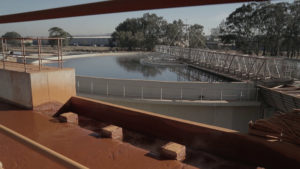Just as IM’s water management feature goes live, ANDRITZ has released details of a project it has been working on to de-water old mines in Johannesburg, South Africa.
South Africa has been dealing with an acid water problem in recent years. Underneath the old gold mining city of Johannesburg is a lake containing heavily contaminated water, which spreads horizontally and vertically into the abandoned pits of the former gold mines, according to ANDRITZ.
The water line has reached a critically high level, as determined by the specialists from the ANDRITZ subsidiary, ANDRITZ Ritz, in Schwaebisch Gmuend, Germany, which was given the first order to drain the mine water back in 2010.
The execution of the project was delayed by four years, however, and it was only in Spring 2014 that two powerful ANDRITZ submersible motor pumps were installed in the middle of Johannesburg city centre, in the so-called ‘Central Basin’. Each pump is capable of bringing 1,500 m³/h (1.5 million litres per hour) of water to the surface, according to ANDRITZ; with 60 million litres of water per day pump, it is a never-ending task, ANDRITZ said.
“In Johannesburg, however, acid mine water is an ongoing problem. Rainwater seeps into the tunnels and reacts chemically with residual minerals like pyrite, producing corrosive sulphuric acids. In the worst case scenario, this can result in a pH value of 2, which is enough to cause lasting damage to humans and the environment.
“Because of this corrosive acid, the Johannesburg pumps had to be completely redesigned. The design is based on ANDRITZ’s proven HDM (Heavy Duty Mining) technology, which uses the concept of a double-suction pump. The thrusts produced are offset by the counter-rotating arrangement of the impellers and the pumps run without axial thrust, giving a properly maintained pump a service life of 10 to 15 years.”
The pumps for the Johannesburg project are a tailor-made, customised design built for this special individual application, according to ANDRITZ. Part of the new system is an encapsulation of the submersible motors (see top photo), which enables the creation of an internal pressure higher than the external pressure. This prevents the intrusion of the corrosive water and the components inside the motor being attacked and possibly destroyed. “At the same time, the water being drained is used to cool the motor by means of a heat exchanger,” ANDRITZ said.
 ANDRITZ engineers spent weeks developing the sophisticated technology needed to encapsulate the motor so it could withstand the higher internal pressure. The first two pumps have been running since June 2014. These 21-t pumps, each 15 m long with a 1-m diameter, were installed side by side in March, 5 m apart, but could only be started after completion of the water treatment plant.
ANDRITZ engineers spent weeks developing the sophisticated technology needed to encapsulate the motor so it could withstand the higher internal pressure. The first two pumps have been running since June 2014. These 21-t pumps, each 15 m long with a 1-m diameter, were installed side by side in March, 5 m apart, but could only be started after completion of the water treatment plant.
Freely suspended on 430-m-long duplex steel pipes, they transport the acid mine water to the surface and onwards into an adjacent treatment plant (pictured). Here, through the addition of lime, the pH value is raised, the acid is neutralised and the heavy metals dissolved in the water are absorbed and precipitated as hydroxides, ANDRITZ said.
The South African authorities are planning a total of three pumping stations, which will each be developed at the mines’ disused extraction shafts. In addition to the Central Basin in Johannesburg’s city centre, invitations to tender for the ‘Eastern Basin’ and the ‘Western Basin’ are currently in progress, according to ANDRITZ.
“The long-term goal is to force the water level in the flooded mines back from its current level of approximately 200 m to a depth of 1,000 m, and to keep it there, to then be able to begin mining gold and gold ore in the drained upper layers of the mines once again,” the company said.











